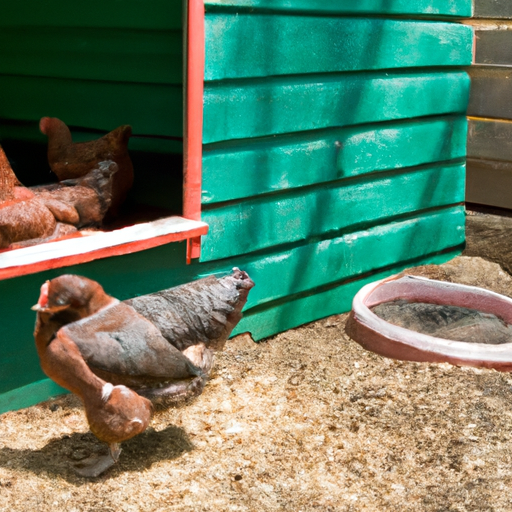When it comes to providing a safe and comfortable haven for your chickens, the choice of shelter is crucial. The right type of shelter can not only protect your feathered friends from the elements but also promote their overall health and well-being. From traditional coops to more innovative designs, this article explores various options and highlights the key factors to consider when selecting the best shelter for your chickens. So, whether you are a seasoned chicken enthusiast or just starting your flock, read on to discover the perfect shelter that will keep your chickens clucking happily.
Factors to Consider
When it comes to choosing the best shelter for your chickens, there are several factors that you need to consider. These factors will play a crucial role in determining the type of shelter that would be most suitable for your feathered friends. Here are the key factors to keep in mind:
Climate
The climate in your region is an important consideration when it comes to providing the right shelter for your chickens. Different chicken breeds have varying tolerances to heat, cold, and humidity. If you live in an area with harsh winters or scorching summers, you will need to choose a shelter that provides adequate insulation or ventilation to ensure the comfort and well-being of your flock.
Number of Chickens
The size of your flock will also dictate the type and size of shelter you need. If you have a small flock, a compact coop or tractor may be sufficient. However, if you have a larger number of chickens, you will need a more spacious shelter to accommodate them comfortably.
Space Availability
Consider the amount of space you have available for a chicken shelter. If you have a small backyard, you may need to opt for a compact coop or a portable tractor that can easily be moved around. On the other hand, if you have ample space, you can consider larger options such as chicken runs or even free-range setups.
Predator Protection
Protecting your chickens from predators is crucial for their safety. Depending on the type of predators in your area, you may need to choose a shelter that provides adequate protection. This could include reinforced fencing, secure enclosures, or elevated coop designs.
Maintenance
Maintenance is another important factor to consider. Some types of shelters may require more frequent cleaning and maintenance, while others may be easier to maintain. Consider your time and energy constraints when choosing a shelter, as regular upkeep is crucial for the health and well-being of your chickens.
Types of Chicken Shelters
Now that we have discussed the key factors to consider, let’s explore the various types of chicken shelters available:
Coops
Coops are the most common type of chicken shelter and offer a secure and protected environment for your chickens. There are different types of coops available, depending on your needs and preferences.
Traditional Coops
Traditional coops are stationary structures that provide a permanent home for your chickens. They are usually made of wood and can range in size and design. These coops often have nesting boxes and roosting perches, providing a comfortable space for your chickens to lay eggs and rest.
Portable Coops
Portable coops, also known as chicken tractors, are designed to be easily moved around your property. They are usually smaller in size and have wheels or handles for convenient transportation. Portable coops allow your chickens to have access to fresh grass and insects while still being protected from predators.
Walk-In Coops
Walk-in coops, as the name suggests, are larger structures that allow you to walk inside. These coops provide ample space for your chickens to move around and for easy access when cleaning, feeding, or collecting eggs.
Coop Size
When choosing a coop, consider the size requirements based on the number of chickens you have. The general recommendation is to provide at least 3-5 square feet of floor space per chicken. This allows them to move around comfortably and exhibit natural behaviors.
Ventilation
Proper ventilation is essential in any coop to ensure good air quality and prevent the buildup of harmful gases. Coops should have openings or windows positioned to provide cross ventilation, allowing fresh air to circulate while expelling stale air.
Tractors
Chicken tractors are a versatile option that combines the benefits of a coop with the ability to move the shelter regularly. They are often smaller and mobile structures that allow your chickens to access fresh forage while still providing protection.
Definition and Purpose
A chicken tractor is essentially a portable coop that allows your chickens to scratch, peck, and fertilize the ground in a designated area. By regularly moving the tractor, your chickens can enjoy fresh grass, insects, and other natural elements, contributing to their overall health and happiness.
Portability and Design
Chicken tractors are designed to be easily moved around your property, allowing your flock to explore different areas without harming the vegetation. They often have wheels for easy transportation and may include run extensions for additional space.
Pros and Cons
One advantage of chicken tractors is that they provide your chickens with fresh food sources and enrichment, mimicking their natural foraging behaviors. Tractors can also help with lawn maintenance by allowing your chickens to fertilize and till small sections of your yard.
However, it’s important to note that chicken tractors may not provide as much space as traditional coops. They also require more frequent moves to ensure fresh forage availability and prevent bare patches of ground.
Chicken Runs
Chicken runs are enclosed areas that provide a larger space for your chickens to move around while still offering protection from predators.
Definition and Purpose
A chicken run is essentially an outdoor enclosure where your chickens can stretch their wings, scratch the ground, and enjoy some fresh air and sunlight. It acts as an extension of the coop, offering a larger outdoor space for your chickens to roam during the day.
Construction Materials
Chicken runs can be constructed using various materials, such as wire mesh or chain-link fencing. The choice of materials will depend on the predators in your area and the desired level of protection. Ensure that the design allows for easy access and maintenance.
Size and Configuration
The size of your chicken run will depend on the number of chickens you have and the available space. As a general guideline, aim for at least 10 square feet of space per chicken. In terms of configuration, consider incorporating different levels, perches, or even plantings to provide enrichment and stimulation for your flock.
Roofing and Netting
To protect your chickens from aerial predators, it is essential to consider adding a roof or netting to your chicken run. This will prevent hawks, owls, and other predatory birds from swooping down and harming your flock.
Greenhouses
Greenhouses can provide a unique and beneficial environment for your chickens, offering protection, warmth, and additional food sources.
Benefits for Chickens
Greenhouses provide a controlled environment that offers protection from harsh weather conditions, including extreme temperatures and high winds. The greenhouse structure also creates a warm microclimate, allowing your chickens to remain comfortable during colder months.
In addition, a greenhouse can extend the growing season, allowing you to cultivate plants that provide additional food sources for your flock. This can help reduce feed costs and provide more diverse nutrition.
Design Considerations
When designing a greenhouse for your chickens, consider the dimensions, materials, and layout. Ensure that the structure is well-secured, with appropriate openings for ventilation and sunlight. You may also want to include dedicated areas for nesting boxes, roosting perches, and even planting beds.
Temperature and Ventilation
Proper temperature control is crucial in a greenhouse. Consider incorporating passive ventilation systems such as adjustable windows, roof vents, or side vents. This will help to regulate temperature and humidity levels, creating a comfortable and healthy environment for your chickens.
Natural Lighting
Access to natural light is important for the well-being of your chickens. Ensure that your greenhouse design allows for adequate sunlight penetration. Consider using translucent materials for the walls and roof to maximize natural light while still providing protection from the elements.
Free-Range
Free-range systems offer the most natural and unrestricted environment for your chickens. However, there are certain considerations to keep in mind when opting for this type of setup.
Benefits and Drawbacks
Free-range systems allow your chickens to roam freely, exhibit natural behaviors, and forage for food. This can lead to happier and healthier chickens. Moreover, free-range eggs are often prized for their superior taste and quality.
However, free-range systems come with their own challenges. Predators pose a significant risk to chickens in open environments, and careful predator control measures need to be implemented. Additionally, foraging chickens may cause damage to landscaping or neighboring properties.
Suitable Environment
Before opting for a free-range system, ensure that your property provides a suitable environment. The area should be securely fenced to prevent predators from gaining access. You may also need to consider the impact on your neighbors and local regulations regarding free-range setups.
Predator Control
Implementing effective predator control measures is essential in a free-range system. This may include reinforced fencing, keeping watchful dogs, or even using protective electric fencing. Regular monitoring and maintenance of the fencing is crucial to ensure that predators are kept out.
Feeding and Shelter
While your chickens can forage for a significant portion of their diet in a free-range system, you still need to provide supplementary feed and appropriate shelter. Ensure that your flock has access to high-quality feed and fresh water at all times. Install shelters or roosting areas to protect them from adverse weather conditions or predators during the night.
Maintenance
Proper maintenance of your chicken shelter is vital for the health and well-being of your flock. Consider the following aspects to ensure a clean and safe environment for your chickens:
Cleaning and Sanitation
Regularly clean your chicken shelter to remove waste, debris, and harmful bacteria. This includes removing soiled bedding, scrubbing surfaces, and disinfecting as needed. Good sanitation practices prevent the spread of diseases and help maintain a healthy flock.
Nesting Materials
Provide suitable nesting materials, such as straw or wood shavings, to create comfortable nests for your chickens. Regularly check and replace nesting materials to ensure cleanliness and prevent mites or other pests from infesting the area.
Routine Inspections
Regularly inspect your chicken shelter to identify any maintenance issues or signs of wear and tear. Look for potential escape routes, holes, or damage that could compromise the safety of your chickens. Promptly address any repairs or maintenance needs to prevent further damage.
Repair and Upkeep
Maintain your chicken shelter by repairing or replacing any damaged or worn-out components. This includes fixing fences, replacing roofing materials, or addressing ventilation issues. Regular upkeep ensures that your shelter remains functional and provides optimal comfort and protection for your flock.
Budget Considerations
While considering the type of shelter for your chickens, it’s important to keep in mind the associated costs. Here are some budget considerations to help you make an informed decision:
Cost of Materials
Different types of chicken shelters come with varying material costs. Traditional coops made of wood may be more expensive than lightweight portable coops or chicken runs constructed with wire mesh. Consider your budget and choose a shelter that meets your needs without exceeding your financial limits.
Professional Construction
If you are not skilled in construction or lack the time and tools necessary, you may choose to hire professionals for the installation of a more complex shelter, such as a walk-in coop or greenhouse. Factor in the cost of professional construction if you decide to go down this route.
Long-Term Expenses
It’s important to consider the long-term expenses associated with chicken shelters. This includes ongoing maintenance, feed costs, and potential repairs. Choose a shelter that aligns with your budget for both upfront and recurring expenses.
Conclusion
Choosing the right shelter for your chickens requires careful consideration of various factors, including climate, flock size, space availability, predator protection, and maintenance requirements. By taking these factors into account and exploring the different types of chicken shelters available, you can make an informed decision that provides a safe, comfortable, and enriching environment for your beloved flock.




